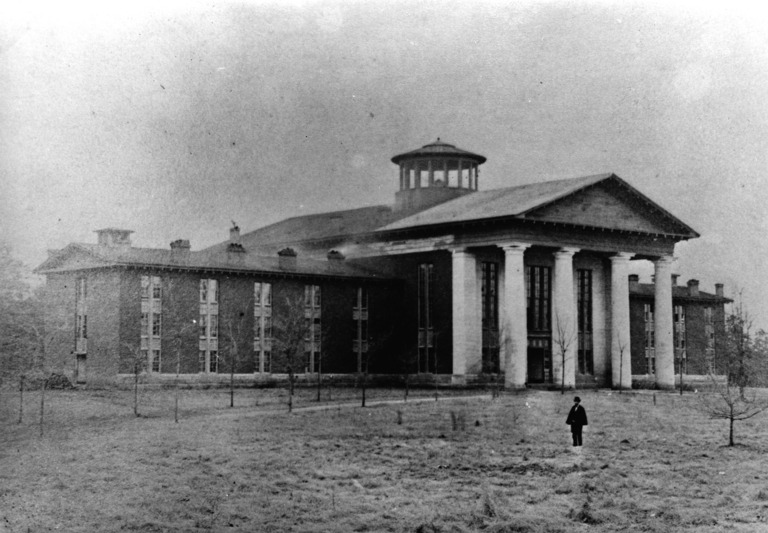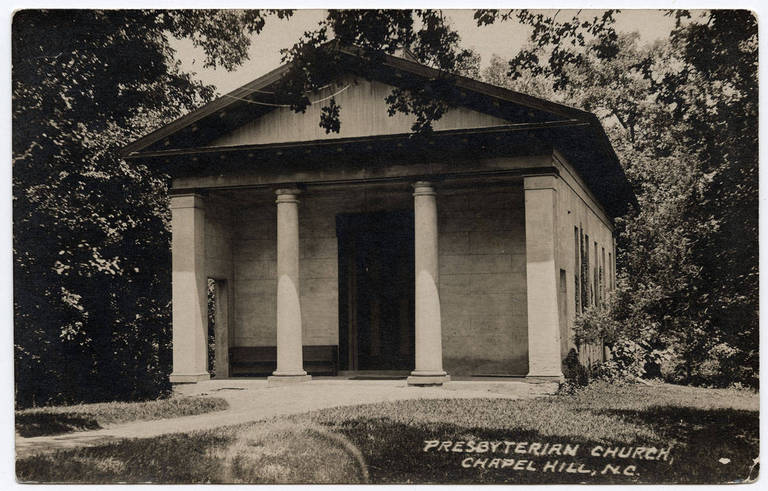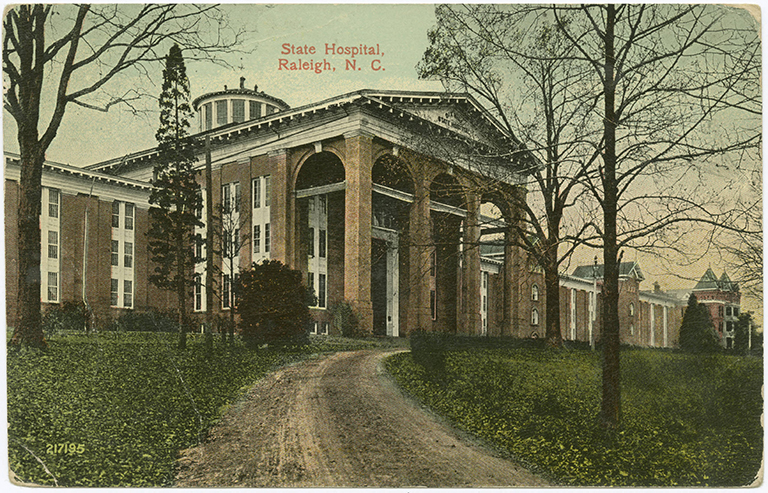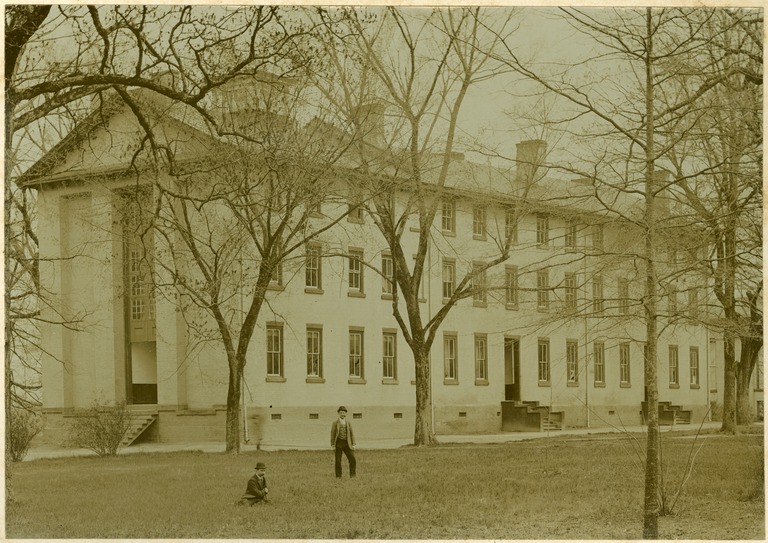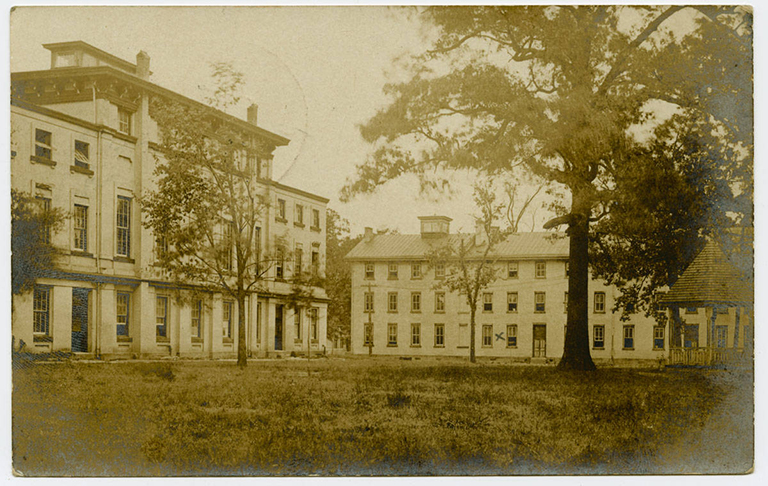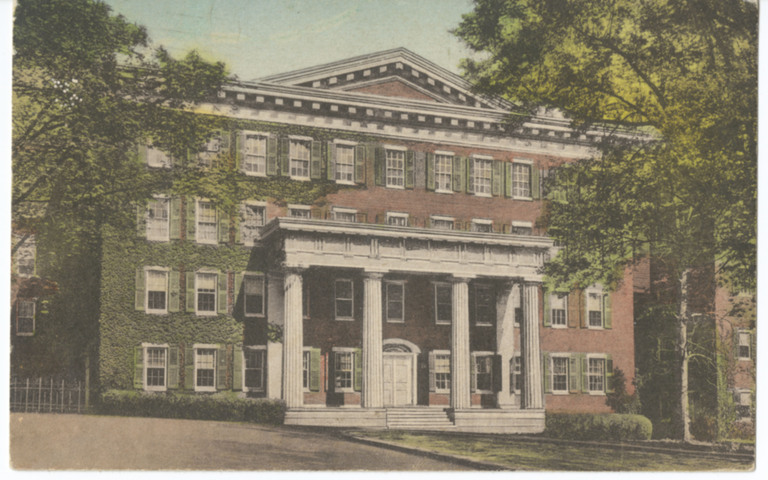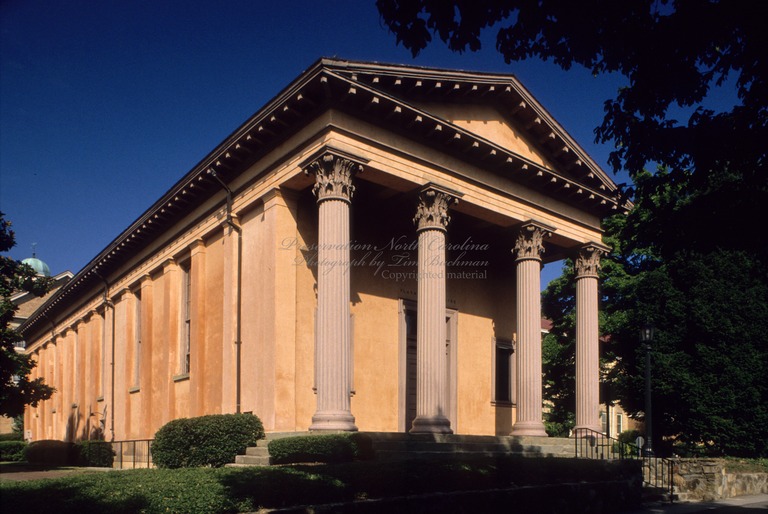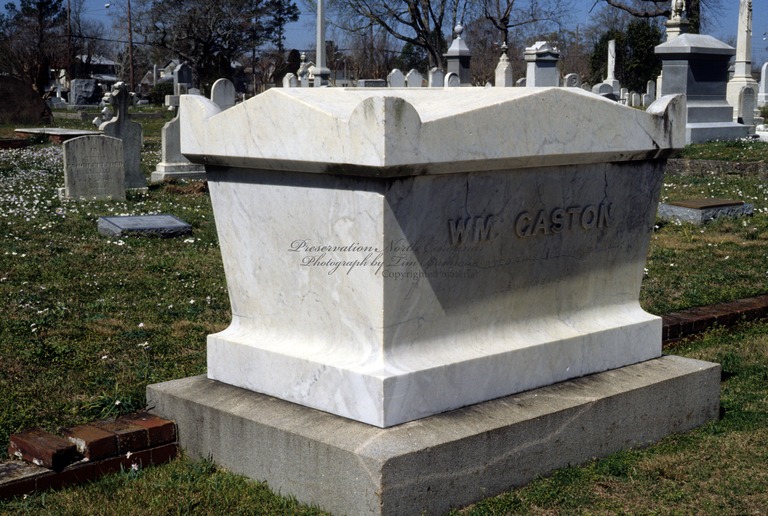Davis, Alexander Jackson (1803-1892)
Variant Name(s):
A. J. Davis
Birthplace:
New York City, New York, USA
Residences:
- New York City, New York
Trades:
- Architect
Building Types:
Styles & Forms:
Gothic Revival; Greek Revival; Italianate
Alexander Jackson Davis (1803-1892), a leading American architect of the antebellum period, had an important series of commissions in North Carolina that were significant both in the development of the state and Davis’s national practice. The monumental North Carolina State Capitol (1833-1840) was designed by the firm of Town and Davis, but his subsequent work in the state was from Davis’s own practice.
Davis was born in New York City to Cornelius and Julia Jackson Davis. The family lived for a time in Utica and Auburn, New York. In 1818 young Alexander went to Alexandria (then in the District of Columbia) to learn the printing trade with his half-brother Samuel at the Alexandria Gazette. He returned to New York in 1823 and made his living typesetting while studying art and architecture, including many hours spent in the architectural library of leading architect Ithiel Town. Davis soon engaged in drawing and preparing for engraving illustrations of New York buildings. He also worked as a draftsman in the office of architect Josiah R. Brady. He visited Boston for architectural study and to draw buildings. These experiences shaped his work as an architect, including his ability to produce beautiful perspective drawings and other drawings, as well as his sense of visual drama. His business cards identified him as an “Architectural Composer.”
In 1829 Davis returned to New York where he “entered into an association” with the much older and more accomplished Ithiel Town. The firm of Town and Davis, regarded by many as the first professional architectural firm in the nation, was a national leader in the quantity and quality of their work. (The partnership continued from 1829 to 1835 and was revived in 1842-1843.) Employing several draftsmen and assistants, the firm planned three state capitols and many residences, stores, churches, and college and government buildings for clients all across the country. Town and Davis specialized in a dignified Greek Revival style with occasional essays in the Gothic Revival. After Town and Davis separated in 1835, Davis worked briefly with Russell Warren, and except for a brief association with Town in 1842-1843, operated his own office until 1878, doing his own drafting and having few employees.
Town and Davis’s connections with North Carolina owed much to Davis’s friendship with Robert Donaldson, a native of Fayetteville and graduate of the University of North Carolina, who had become a wealthy New York resident and arts patron. Davis met Donaldson, perhaps through Town, by about 1830, beginning a long and productive relationship in which Donaldson became an important friend and patron, encouraging Davis’s work in his native state.
Town and Davis’s first project in North Carolina was a design of 1832 for the First Presbyterian Church in Fayetteville, a lively port where Town had previously worked. After the old church—Robert Donaldson’s home church—burned in an 1831 city-wide fire, the firm donated plans for rebuilding.
In 1833 Town and Davis secured the important commission to design the North Carolina State Capitol in Raleigh to replace the State House (see William Nichols), which had also burned in 1831. Early in 1833 Town and Davis had submitted a temple-form design, but the commissioners for the project chose instead a domed, cruciform scheme planned by William Nichols, Jr. Construction began in the spring, with the stone walls begun according to the Nichols cruciform plan, and the cornerstone was inserted on July 4. But later that summer, probably through the influence of Donaldson and his father-in-law, the distinguished state leader William Gaston, Town and Davis reentered the project. Town worked with the commissioners, while in New York Davis drew the designs to redefine the building in their distinctive Greek Revival style. The porticoes followed the chaste Doric order of the Parthenon, complemented by tall pilasters flanking the windows in a characteristic feature of Davis’s work. A low dome capped the central rotunda. Davis never visited Raleigh during the construction of the North Carolina State Capitol. As work proceeded, the working drawings were produced by David Paton, the Edinburgh native sent by Town and Davis in September, 1834, to supervise the stonework. In 1835, the commissioners severed relations with Town and Davis, leaving Paton in charge of completing the building.
After 1835 Davis expanded his own practice with an ever-growing national clientele. He also moved toward greater diversity of styles and forms, experimenting with designs in Egyptian, Tuscan, Italian, and Gothic modes. He was a leader in introducing and popularizing these picturesque romantic styles for country residences and other buildings across much of the nation. Influenced by the English theory of the picturesque, Davis emphasized the importance of linking a country house to its surrounding landscape, as elucidated in his only book, Rural Residences (1837). He soon found a broader outlet for his ideas through association with Andrew Jackson Downing, a landscape designer and publicist who led in the promotion of picturesque ideals in America. The two met in 1838 through their mutual patron, Robert Donaldson. For Downing’s three books, A Treatise on the Theory and Practice of Landscape Gardening (1841), Rural Residences (1842), and The Architecture of Country Houses (1850), Davis helped with the text, contributed designs of many houses, and prepared the drawings.
Robert Donaldson especially encouraged Davis’s work for his alma mater, the University of North Carolina. In 1832 Donaldson commissioned Davis to design a library building for the Philosophical Literary Society and in 1835 to plan a monument to the late president of the university, Joseph Caldwell. Owing to costs, none of these was executed. In 1843, however, the university trustees authorized the president, David L. Swain, to employ a professional designer to develop a plan for landscaping and new buildings at the university. Swain wrote to Donaldson for advice, and Donaldson immediately recommended Davis. (Likewise through the Donaldson connection, Davis also designed a Gothic Revival church, which was never built, for the New Bern Catholic congregation of Donaldson’s father-in-law William Gaston, and designed Gaston’s tombstone which stands in New Bern.) Thus, through Donaldson, Davis began an important series of North Carolina projects.
In January, 1844, Davis visited North Carolina for the first time, keeping a detailed account of his journey. He spent several days at the University of North Carolina in Chapel Hill and traveled to Greensboro with Gov. John Motley Morehead to plan a stylish addition to the governor’s residence, Blandwood. He returned to Chapel Hill to present his plans to the trustees, and then returned to New York to complete the designs. Following advice from Donaldson, for these projects Davis kept economy in mind along with the desire for modernity. This time the work went forward.
For the university, Davis planned additions to the existing Old East and Old West buildings to house the campus Dialectic and Philanthropic Society halls and libraries as well as dormitory rooms. His design extended both brick buildings northward and created dramatic north façades in his bold Tuscan style with tall pilasters carrying a pediment, giving a modern and monumental character to relatively simple buildings. The additions were completed in 1847 by local builders Kendall B. Waitt, Isaac J. Collier, and Dabney Cosby, with plastering done by Cosby’s skilled slaves Albert and Osborne. The interiors of the libraries and literary halls were executed by noted Caswell County free black cabinetmaker Thomas Day.
For Gov. Morehead’s Greensboro home, Blandwood, Davis designed a front addition that was one of the first towered Italianate villas in the nation. Pleased with this design, Davis featured a drawing of it in Downing’s journal, The Horticulturist, and it subsequently appeared in Downing’s Treatise on Landscape Gardening, which promoted both the new house form and Davis’s popularity. Finished in simple Tuscan style, the stuccoed brick addition was completed in 1846 by the local Conrad family of builders.
These commissions led to others among the progressive leaders of the state. In Chapel Hill, University of North Carolina President David L. Swain, an elder in the Chapel Hill Presbyterian Church, asked Davis to design a church in Gothic style with a steeple, but Davis responded early in 1847 that such a church would be too costly and suggested a “Vitruvian Tuscan” mode as less expensive and “more expressive of the purpose, (Protestant worship) than the Gothic.” The church of stuccoed brick featured a simple portico with Tuscan columns. Davis’s published designs likewise attracted commissions, as was the case when Edwin M. Holt, a wealthy pioneering textile manufacturer of present-day Alamance County, wrote to Davis after noticing his design for “A Small Villa” in Downing’s Horticulturalist (Jan. 1849). Encouraged by a friend, probably Governor Morehead, Holt asked Davis for plans for such a house, adapted to be an addition to his existing house. The small frame villa, economical but boldly modern, was completed by a local carpenter and known as Locust Grove. Other progressive leaders likewise approached Davis for house designs, including William A. Graham of Hillsborough, who also wanted to expand an existing dwelling. Davis sketched two alternatives, one Gothic Revival, the other Italianate, but Graham decided to build a simpler addition more in keeping with local architecture. Others of Davis’s residential designs were executed, but none still stands.
Davis’s chief works of the 1850s encompassed some of the state’s most important educational and institutional edifices. Although much of his work nationally showed his skill with the Gothic Revival style, for his North Carolina works he continued to employ classical elements and, especially, the simple, massive forms of the economical Tuscan mode.
In 1850 Davis visited North Carolina to begin planning for the huge North Carolina Hospital for the Insane (now Dorothea Dix Hospital) just west of Raleigh. Inspired by the reformer Dorothea Dix, the state had authorized an asylum for the insane as a major step in humanitarian treatment and social progress. Morehead, who chaired the commission for the project, stated the commissioners’ desire for “a model institution” and urged, “give us the best plan in the United States.” Davis, working from the philosophy of Dr. Thomas Kirkbride, planned an enormous 3-story building 726 feet long, with a 4-story central pavilion with colossal arcade and octagonal lantern. Again he used his Tuscan mode with bold, simple forms in stuccoed brick. The flanking wings, one for male and one for female patients, gained monumentality from his trademark “Davisean” windows between broad pilasters beneath a bracketed roofline. He also called for indoor plumbing, steam heating, and gas lighting, advanced features in Raleigh in 1850. His detailed specifications survive, using a standardized format that he had recently adopted. The building was finished in 1856 at a cost of nearly $300,000. Davis was paid $552.25 for his drawing and specifications.
At the University of North Carolina, Davis worked through several stages of planning to design Smith Hall (Playmakers Theatre), a small but imposing temple-form building for a library and ballroom. He used the pilasters and cornice of the Tuscan style combined with a beautifully detailed portico with custom-designed columns in a Corinthian mode with corn and wheat at the capitals. Throughout the process he corresponded with University of North Carolina President David L. Swain and Hillsborough builder John Berry about practical and esthetic questions.
Other projects for colleges and schools included a brick building with Doric portico for the Greensboro Female Academy (now Greensboro College) and the Salem College Main Building, again with Doric portico but without other Davis hallmarks, on which he was consulted by Salem leader Francis Fries (and friend of Morehead) who was visiting New York. Davis also proposed several projects at the University of North Carolina, but none was built; by the late 1850s the university was looking to the Raleigh-based newcomer architect William Percival.
Davis’s most ambitious college project was for Davidson College, a small Presbyterian college near Charlotte that in 1855 had become one of the best-endowed colleges in the nation from a bequest from Salisbury businessman Maxwell Chambers. Davis planned a campus complex that, had it been completed, would have been unequaled in scope in the nation. He designed an enormous 3-story complex that formed a large quadrangle, accentuated by pavilions centered on two of the four sides. The exterior treatment, like his Hospital for the Insane in Raleigh featured his trademark “Davisean” windows flanked by pilasters. The main pavilion had a domed lantern and a massive Tuscan portico. Opposite it was to be a circular pavilion for a dining hall. The project began in 1856 with the main contractor John Nichols Scofield corresponding with Davis regularly. Only part of one side of the quadrangle, which included the main pavilion, was completed before the Civil War stopped construction. It was named Chambers Hall for the benefactor. The complex was never finished, and “Old Chambers” burned in the early 20th century. Another building was erected and called Chambers Hall. A monument he planned in 1868 to commemorate his friend David L. Swain, president of the University of North Carolina, remained unbuilt. Although Davis did no more work in North Carolina after the Civil War, he kept in touch with old friends in the state for many years.
For nearly twenty years Davis took a unique role in North Carolina’s architectural development. He was the only major American architect of his era with a sizable body of work in the state. Working effectively with the political, educational, and industrial leaders intent on bringing progress to the rural state, he designed buildings that manifested their progressive spirit. The state offered Davis unique opportunities to work out his ideas with supportive clients, limited only by their pocketbooks. David Swain, president of the university, once wrote to him, with “faith in your skill . . . we have determined to trust everything to your genius.” North Carolina was graced by some of Davis’s most important and innovative buildings, which form a vital part of the state’s heritage and of Davis’s national legacy. The principal collections of Alexander Jackson Davis’s papers are held at the Metropolitan Museum of Art, the Avery Library of Columbia University, the New York Public Library, and the New York Historical Society, all in the City of New York.
- John V. Allcott, “Architect A. J. Davis in North Carolina,” North Carolina Architect, 20 (1975).
- John V. Allcott, “Architectural Developments at Montrose in the 1850s,” North Carolina Historical Review, 42 (1965).
- John V. Allcott, “Robert Donaldson, the First North Carolinian to Become Prominent in the Arts,” North Carolina Historical Review, 52 (1974).
- John V. Allcott, “Scholarly Books and Frolicsome Blades: A. J. Davis Designs a Library-Ballroom,” Journal of the Society of Architectural Historians, 33.2 (May 1974).
- John V. Allcott, The Campus at Chapel Hill: Two Hundred Years of Architecture (1986).
- Jean Bradley Anderson, Carolinian on the Hudson: The Life of Robert Donaldson (1996).
- Catherine W. Bishir, North Carolina Architecture (1990).
- Jane B. Davies, “Introduction: Alexander J. Davis, Creative American Architect,” in Amelia Peck, ed., Alexander Jackson Davis: American Architect, 1803-1892 (1992).
- Edward T. Davis and John L. Sanders, A Romantic Architect in Antebellum North Carolina: The Works of Alexander Jackson Davis (2000).
- Amelia Peck, ed., Alexander Jackson Davis: American Architect, 1803-1892 (1992).
- John L. Sanders, “The North Carolina State Capitol of 1840,” The Magazine Antiques (Sept. 1985).
Blandwood
Contributors:Conrad Family, builders; Joseph Conrad, builder; William Conrad, builder; Alexander Jackson Davis, architectDates:1844-1845
Location:Greensboro, Guilford CountyStreet Address:400 W. Washington St., Greensboro, NC
Status:Standing
Type:Residential
Images Published In:Catherine W. Bishir, North Carolina Architecture (1990).
Edward T. Davis and John L. Sanders, A Romantic Architect in Antebellum North Carolina: The Works of Alexander Jackson Davis (2000).
Chambers Hall
Contributors:Alexander Jackson Davis, architect; John Nichols Scofield, builderVariant Name(s):Davidson College Main Building
Dates:1856-1860
Location:Davidson, Mecklenburg CountyStreet Address:Davidson College, Davidson, NC
Status:No longer standing
Type:Educational
Images Published In:Catherine W. Bishir, North Carolina Architecture (1990).
Edward T. Davis and John L. Sanders, A Romantic Architect in Antebellum North Carolina: The Works of Alexander Jackson Davis (2000).Note:Architect Alexander Jackson Davis drew plans for an immense quadrangle, of which only one section was completed. Several images of the proposed and constructed building appear in Edward T. Davis and John L. Sanders, A Romantic Architect in Antebellum North Carolina: The Works of Alexander Jackson Davis (2000), including a romantic bird’s-eye view landscape centered on the envisioned quadrangle. Chambers Hall burned in 1921 and another large building was erected and given the name Chambers.
Chapel Hill Presbyterian Church
Contributors:Dates:1845-1848
Location:Chapel Hill, Orange CountyStreet Address:200 block E. Franklin St., Chapel Hill, NC
Status:No longer standing
Type:Religious
Images Published In:Catherine W. Bishir, Charlotte V. Brown, Carl R. Lounsbury, and Ernest H. Wood III, Architects and Builders in North Carolina: A History of the Practice of Building (1990).
Edward T. Davis and John L. Sanders, A Romantic Architect in Antebellum North Carolina: The Works of Alexander Jackson Davis (2000).
M. Ruth Little, The Town and Gown Architecture of Chapel Hill, North Carolina, 1795-1975 (2006).
David P. Weir House (unbuilt)
Contributors:Alexander Jackson Davis, architectDates:1844
Location:Greensboro, Guilford CountyStreet Address:Greensboro, NC
Status:Unbuilt
Type:Residential
Images Published In:Edward T. Davis and John L. Sanders, A Romantic Architect in Antebellum North Carolina: The Works of Alexander Jackson Davis (2000).
Note:Davis supplied Weir with a design for an elaborate English style house, but it was evidently never built, and Weir built a simpler residence a few years later (see “David P. Weir House” in W. S. Andrews).
Edgeworth Female Seminary
Contributors:Alexander Jackson Davis, possible architect; David McKnight, brickmasonDates:1840s
Location:Greensboro, Guilford CountyStreet Address:Greensboro, NC
Status:No longer standing
Type:Educational
Note:The seminary was established and owned by John Motley Morehead. Methodist minister N. H. D. Wilson recalled that it was built by David McKnight. An article in the Greensboro Patriot of May 3, 1842, lauded its “extensive” buildings in “fine Architectural taste, erected for the purpose.” In 1853, architect Alexander Jackson Davis was asked to provide a design for the school. He noted in his daybook, May 20, 1853, “Mr. Conrad visited N. Y. I make drawings for Gov. Morehead’s Edgeworth, Greensboro, plan, elev. front rear end on yellow paper, $10.00” (Alexander Jackson Davis Collection, New York Public Library). It is not known whether Davis’s plan was executed. During the Civil War, the school closed and its facilities burned.
First Presbyterian Church
Contributors:Alexander Jackson Davis, architect (1832); Hobart Upjohn, architect (1924)Dates:1832; 1924
Location:Fayetteville, Cumberland CountyStreet Address:SE corner of Bow St. and Ann St., Fayetteville, NC
Status:Altered
Type:Religious
Images Published In:Edward T. Davis and John L. Sanders, A Romantic Architect in Antebellum North Carolina: The Works of Alexander Jackson Davis (2000).
Note:After First Presbyterian Church burned, Town and Davis provided a design for its restoration, including the roof truss, which survives in the attic after many changes to the building. Hobart Upjohn designed the steeple and the parish house which were added before 1924.
Greensboro College
Contributors:Alexander Jackson Davis, possible architect (additions); David McKnight, brickmasonVariant Name(s):Greensboro Female Academy
Dates:1843-1861
Location:Greensboro, Guilford CountyStreet Address:W. Market St., Greensboro College Campus, Greensboro, NC
Status:No longer standing
Type:Educational
Images Published In:Marvin A. Brown, Greensboro: An Architectural Record (1995).
Note:The school was established by Methodists in 1838. Its Main Building was begun in 1843 and opened its doors in 1846. The Greensboro Patriot of Saturday, August 26, 1843, carried an account of the laying of the cornerstone of the Greensboro Female College the previous Saturday. The building was to be 132 feet long and 52 feet high and three stories tall, in “plain” but “durable” style. No mention was made of the architect or builders. It was expanded in sections over several years and burned in 1865. According to Davis and Sanders, A Romantic Architect in Antebellum North Carolina (28), architect Alexander Jackson Davis was asked to provide a design for the school in 1851, but it is not known if such was executed; the Italianate side additions may reflect Davis’s designs. Methodist minister N. H. D. Wilson was surely accurate in crediting construction to David McKnight.
Jesse Lindsay House
Contributors:Alexander Jackson Davis, architectDates:1852
Location:Greensboro, Guilford CountyStreet Address:Greensboro, NC
Status:No longer standing
Type:Residential
Images Published In:Edward T. Davis and John L. Sanders, A Romantic Architect in Antebellum North Carolina: The Works of Alexander Jackson Davis (2000).
Joseph Caldwell Monument
Contributors:Alexander Jackson Davis, architectDates:1835
Location:Chapel Hill, Orange CountyStreet Address:University of North Carolina, Chapel Hill, NC
Status:Unbuilt
Type:Memorial
Locust Grove
Contributors:Alexander Jackson Davis, architect; Eli Denny, contractorVariant Name(s):Edwin M. Holt House
Dates:1849
Location:Alamance, Alamance CountyStreet Address:NC 62, Alamance vicinity, NC
Status:Standing
Type:Residential
Images Published In:Catherine W. Bishir, North Carolina Architecture (1990).
Edward T. Davis and John L. Sanders, A Romantic Architect in Antebellum North Carolina: The Works of Alexander Jackson Davis (2000).Note:On March 2, 1849, industrialist Edwin M. Holt wrote to architect Alexander Jackson Davis, “My attention has lately be[en] called to a design in the January No. of the Horticulturalist, though that design does not suit me, yet a friend insists on my calling on you for a design. He requested a sketch and cost estimates and commented, “I would here remark that all the designs I have seen are better calculated for a Northern than a Southern climate you must recall that we of the South never have the kitchen, the wash & wood house in our dwellings, our Kitchen is always in a separate building.” He sought an “immediate answer,” because “my workmen are to commence (on this plan) on the 20th Inst.” Holt had already employed local builder Eli Denny to build his house—actually an addition to an existing dwelling—and once the design was settled, work began on March 19 and was fished by summer. (E. M. Holt to A.J. Davis, March 2, 1849, Davis Letterbook, A. J. Davis Collection, New York Public Library, quoted in Bishir, North Carolina Architecture.
Montrose
Contributors:Alexander Jackson Davis, architectVariant Name(s):William A. Graham House
Dates:1850
Location:Hillsborough, Orange CountyStreet Address:Hillsborough vicinity, NC
Status:Unbuilt
Type:Residential
Images Published In:John V. Allcott, “Architectural Developments at Montrose in the 1850s,” North Carolina Historical Review, 42 (1965).
Edward T. Davis and John L. Sanders, A Romantic Architect in Antebellum North Carolina: The Works of Alexander Jackson Davis (2000).
North Carolina Hospital for the Insane
Contributors:Eleazar Colbourn, stone contractor; Conrad Family, contractors; Conrad and Williams, carpentry contractors; Dabney Cosby, brickwork contractor; Alexander Jackson Davis, architect; Stewart Ellison, carpenter; David McKnight, brick contractor; S. L. McKnight, plastering contractorVariant Name(s):Dorothea Dix Hospital
Dates:1850-1852
Location:Raleigh, Wake CountyStreet Address:Dorothea Dix Hospital Campus, Western Boulevard, Raleigh, NC
Status:Altered
Type:Health Care
Images Published In:Catherine W. Bishir, North Carolina Architecture (1990).
Edward T. Davis and John L. Sanders, A Romantic Architect in Antebellum North Carolina: The Works of Alexander Jackson Davis (2000).
North Carolina State Capitol
Contributors:William W. Birth, superindendent, masonry department (1833-1834); Thomas Bragg, Sr., supervisor (1830s); John J. Briggs, carpenter (1830s); Thomas H. Briggs, Sr., carpenter (1830s); Alexander Jackson Davis, architect (1830s); William Drummond, supervisor (1830s); Robert Findlater, stonecutter (1830s); Asa King, carpenter (1830s); William Murdoch, stonecutter (1830s); William Nichols, architect (1830s); William Nichols, Jr., architect (1830s); David Paton, architect and supervisor (1830s); Henry J. Patterson, brickmaker (1830s); William Percival, architect (1858); James Puttick, stonecutter (1830s); William Strickland, consulting architect (1830s); William Stronach, stonecutter (1830s); Town and Davis, architects (1830s); Ithiel Town, architect (1830s)Dates:1833-1840
Location:Raleigh, Wake CountyStreet Address:Union Square, Raleigh, NC
Status:Standing
Type:Public
Images Published In:Catherine W. Bishir, North Carolina Architecture (1990).
Catherine W. Bishir and Michael T. Southern, A Guide to the Historic Architecture of Piedmont North Carolina (2003).
Edward T. Davis and John L. Sanders, A Romantic Architect in Antebellum North Carolina: The Works of Alexander Jackson Davis (2000).Note:Although sometimes credited solely to Town and Davis, the design of the capitol was the result of a sequence of work by William Nichols, Sr. and Jr., Town and Davis, and David Paton, with advice from William Strickland. For a fuller explanation of the chronology and contributions of architects involved in the State Capitol, see Bishir, North Carolina Architecture and other sources cited herein.
Old East
Contributors:Albert and Osborne, plasterers (1844-1848); Atwood and Nash, architects and engineers (1924); Thomas C. Atwood, engineer (1924); Isaac J. Collier, contractor (1844-1848); Dabney Cosby, brick contractor (1844-1848); Alexander Jackson Davis, architect (1844-1848); Thomas Day, cabinetmaker (1844-1848); Arthur C. Nash, architect (1924); William Nichols, architect (1822); James Patterson, builder (1793-1795); Kendall B. Waitt, contractor (1844-1848)Dates:1793-1795; 1822 [addition]; 1844-1848 [addition]; 1924 [internally reconstructed]; 1991-1992 [extensive renovation]
Location:Chapel Hill, Orange CountyStreet Address:University of North Carolina, Chapel Hill, NC
Status:Standing
Type:Educational
Images Published In:John V. Allcott, The Campus at Chapel Hill: Two Hundred Years of Architecture (1986).
Catherine W. Bishir, North Carolina Architecture (1990).
Catherine W. Bishir and Michael T. Southern, A Guide to the Historic Architecture of Piedmont North Carolina (2003).
Edward T. Davis and John L. Sanders, A Romantic Architect in Antebellum North Carolina: The Works of Alexander Jackson Davis (2000).
M. Ruth Little, The Town and Gown Architecture of Chapel Hill, North Carolina, 1795-1975 (2006).
William S. Powell, The First State University: A Pictorial History of the University of North Carolina (1992).Note:Old East is the oldest building on UNC campus. It was enlarged and given the Tuscan end bay by Alexander Jackson Davis. See North Carolina Architecture and Architects and Builders in North Carolina for details and J. Marshall Bullock, “The Enterprising Contractor, Mr. Cosby,” for a detailed account of Dabney Cosby’s involvement in the Old East and Old West projects. As documented in extensive correspondence, Thomas Day planned and produced the interior woodwork, seating, etc. for the library and debating hall in Old East. Nothing is known to survive of his work there. The building was gutted and rebuilt within the old walls in 1924.
Old West
Contributors:Albert and Osborne, plasterers (1844-1848); Atwood and Nash, architects and engineers (1924); Thomas C. Atwood, engineer (1924); Isaac J. Collier, contractor (1844-1848); Dabney Cosby, brick contractor (1844-1848); Alexander Jackson Davis, architect (1844-1848); Thomas Day, cabinetmaker (1844-1848); Arthur C. Nash, architect (1924); William Nichols, architect (1822-1823); Kendall B. Waitt, contractor (1844-1848)Dates:1822-1823; 1844-1848 [addition]; 1924 [renovation]; 1991-1992 [extensive renovation]
Location:Chapel Hill, Orange CountyStreet Address:University of North Carolina, Chapel Hill, NC
Status:Standing
Type:Educational
Images Published In:John V. Allcott, The Campus at Chapel Hill: Two Hundred Years of Architecture (1986).
Catherine W. Bishir, North Carolina Architecture (1990).
Catherine W. Bishir and Michael T. Southern, A Guide to the Historic Architecture of Piedmont North Carolina (2003).
Edward T. Davis and John L. Sanders, A Romantic Architect in Antebellum North Carolina: The Works of Alexander Jackson Davis (2000).
M. Ruth Little, The Town and Gown Architecture of Chapel Hill, North Carolina, 1795-1975 (2006).
William S. Powell, The First State University: A Pictorial History of the University of North Carolina (1992).Note:Alexander Jackson Davis enlarged and remade the north façades of Old East and Old West with Tuscan end bays to face Franklin Street. Builder Dabney Cosby questioned his design. As documented in extensive correspondence, Thomas Day planned and produced the interior woodwork, seating, etc. for the library and debating hall in Old West. Nothing is known to survive of his work there. See J. Marshall Bullock, “The Enterprising Contractor, Mr. Cosby,” for a detailed account of Cosby’s involvement in the Old East and Old West projects. The photograph shows Old West on the right.
Philanthropic Society Building
Contributors:Alexander Jackson Davis, architectDates:1832
Location:Chapel Hill, Orange CountyStreet Address:University of North Carolina, Chapel Hill, NC
Status:Unbuilt
Type:Educational
Roman Catholic Church
Contributors:Alexander Jackson Davis, architectDates:1834
Location:New Bern, Craven CountyStreet Address:New Bern, NC
Status:Unbuilt
Type:Religious
Images Published In:Edward T. Davis and John L. Sanders, A Romantic Architect in Antebellum North Carolina: The Works of Alexander Jackson Davis (2000).
Salem College Main Building
Contributors:Alexander Jackson Davis, consulting architect; Francis Fries, contractorDates:1853-1856
Location:Winston-Salem, Forsyth CountyStreet Address:601 S. Church St., Winston-Salem, NC
Status:Standing
Type:Educational
Images Published In:Molly Grogan Rawls, Old Salem and Salem College (2010).
Molly Grogan Rawls, Winston-Salem in Vintage Postcards (2004).
Smith Hall
Contributors:Atwood and Nash, architects and engineers (1924-1925); Thomas C. Atwood, engineer (1924-1925); John Berry, builder (1849-1852); Alexander Jackson Davis, architect (1849-1852); Arthur C. Nash, architect (1924-1925); Henry Richards, Sr., attributed brickmason (1849-1852)Variant Name(s):Playmakers Theatre
Dates:1849-1852; 1924-1925 [internally reconstructed]
Location:Chapel Hill, Orange CountyStreet Address:University of North Carolina, Chapel Hill, NC
Status:Standing
Type:Educational
Images Published In:John V. Allcott, “Scholarly Books and Frolicsome Blades: A. J. Davis Designs a Library-Ballroom,” Journal of the Society of Architectural Historians, 33.2 (May 1974).
Catherine W. Bishir, North Carolina Architecture (1990).
Edward T. Davis and John L. Sanders, A Romantic Architect in Antebellum North Carolina: The Works of Alexander Jackson Davis (2000).
South Building and Chapel
Contributors:Alexander Jackson Davis, architectDates:1844-1856
Location:Chapel Hill, Orange CountyStreet Address:University of North Carolina, Chapel Hill, NC
Status:Unbuilt
Type:Educational
William Gaston Sarcophagus
Contributors:Alexander Jackson Davis, architectDates:Ca. 1844
Location:New Bern, Craven CountyStreet Address:Cedar Grove Cemetery, New Bern, NC
Status:Standing
Type:Memorial
Images Published In:Edward T. Davis and John L. Sanders, A Romantic Architect in Antebellum North Carolina: The Works of Alexander Jackson Davis (2000).


